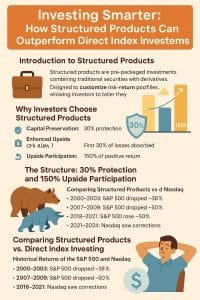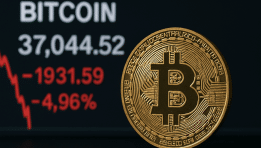
When it comes to investing, especially in uncertain market conditions, choosing the right strategy can be the difference between peace of mind and sleepless nights. Investors often flock to index funds like the S&P 500 or Nasdaq for their historical performance and diversification benefits. But what if you could tap into that same market potential—with a safety net and a boost in positive returns?
That’s exactly what structured products offer. Specifically, we’re diving into a product tied to the S&P or Nasdaq index that gives you 30% downside protection and 150% upside participation if the index yields positive returns over a defined period of 3, 4, or 5 years. Sound too good to be true? Let’s break it all down and see why it might be a smarter move than just investing directly in the indexes.
Introduction to Structured Products
What Are Structured Products?
Structured products are pre-packaged investments that typically combine traditional securities (like bonds) with derivatives. They are designed to provide customized risk-return profiles, allowing investors to tailor their exposure to market conditions.
Unlike plain vanilla index funds, structured products can include built-in features such as downside protection, participation in market gains, or even capped returns. The objective? To give investors a more controlled investment outcome while still participating in market trends.
They’re not new—structured products have been used by institutional investors for decades. But today, more retail investors are discovering their power, especially when market volatility makes pure equity investments feel risky.
Why Investors Choose Structured Products
Here’s why these types of products are gaining traction:
- Capital Preservation: With 30% protection, your investment is safe unless the index drops more than 30%.
- Enhanced Upside: If the market goes up, you don’t just follow—you outperform, thanks to 150% participation.
- Defined Time Horizon: You know exactly when you’ll get your money back and under what terms, unlike the uncertainty of direct equity investing.
- Diversification Tool: They offer exposure to market performance without full exposure to market risk.
Structured products provide a hybrid approach—offering growth potential like equities but with features typically associated with fixed-income products.
The Structure: 30% Protection and 150% Upside Participation
Breakdown of the Investment Terms
Let’s get specific. Here’s how this structured product works:
- Underlying: S&P 500 or Nasdaq Index
- Term: 3, 4, or 5 years
- Downside Protection: First 30% of losses are absorbed (you don’t lose until the index drops more than 30%)
- Upside Participation: If the index finishes the term above its starting point, you earn 150% of the positive return
- Principal at Risk Beyond 30%: If the index falls more than 30%, you participate in the loss beyond that threshold
This means if the S&P grows 20% over 5 years, you get 30% return (150% of 20%). If it drops 25%, you still get your full principal back. Only if it drops more than 30% do you begin to lose capital.
How the 30% Protection Works
This is the cornerstone of the structure. It’s not just a marketing gimmick—it’s a contractual feature built into the product.
The 30% protection means that as long as the index doesn’t fall more than 30% by the end of the term, your principal is safe. This is ideal for risk-averse investors or those who remember the sting of market crashes like 2008 or March 2020.
In a volatile world where geopolitical tensions, inflation, and interest rate hikes can spark massive short-term drops, this buffer acts like an airbag—reducing your risk of serious financial injury.
This isn’t a guarantee from the stock market—it’s structured into the financial product using bonds and derivatives, offering more predictability and control.
The Magic of 150% Participation in Positive Returns
Now let’s talk upside. If the market ends your investment period above where it started, you don’t just match it—you outperform it.
For example:
- If Nasdaq gains 10%, your structured note gives you 15%.
- If the S&P gains 25%, you get 37.5%.
That 150% participation is achieved through leverage built into the derivative component. It’s like having your cake and eating it too—boosting your gains without exposing yourself fully to the downsides of leverage.
This can be a game-changer for investors looking for moderate gains with protection, rather than risky bets or low-yield bonds.
Comparing Structured Products vs. Direct Index Investing
The Case for Index Investing
Index investing has long been a favorite for long-term investors. It’s simple, low-cost, and historically has provided strong returns.
The average annual return of the S&P 500 is around 8%, and Nasdaq has historically delivered even higher. Over the long haul—20+ years—indexes are hard to beat.
But here’s the catch: not everyone has 20 years. And the market doesn’t always cooperate in the short term.
Historical Returns of the S&P 500 and Nasdaq
Let’s take a look at actual 3–5 year windows in the market:
- 2000–2003: S&P 500 dropped ~38%
- 2007–2009: S&P 500 dropped ~50%
- 2018–2021: S&P 500 rose ~50%
- 2021–2024: Nasdaq saw sharp corrections, even with tech dominance
As you can see, index investing is not guaranteed to make you money in 3–5 years. Volatility, economic downturns, and black swan events can derail even the best portfolios in the short term.
Structured products address this by offering protection from these downturns—at least up to 30%.
Risks of Index Investing Over 3–5 Years
If you put $100,000 into the S&P 500 or Nasdaq, you might expect that to grow by 8% per year. But in any given 3-year window, your returns could be:
- Positive
- Flat
- Negative
And if you’re planning for something like a home purchase, college tuition, or early retirement, that kind of uncertainty is nerve-wracking.
With structured products, your worst-case scenario is better defined. You might not get the full gains of a booming bull market, but you’ll avoid the worst of a crash.
Why 3, 4, or 5 Years Matter in Structured Products
Market Cycles and Short-Term Volatility
Markets go up in the long term, but they can go all over the place in the short term. A 3–5 year time frame can include corrections, bear markets, or just stagnant periods.
Having a structure that locks in terms over a defined period gives investors an edge—especially when markets are choppy.

Benefits of Defined Time Horizons
One of the greatest emotional traps in investing is reacting to short-term news. But structured products with 3–5 year maturities eliminate that urge.
You’re not watching the market every day, panicking over drops, or selling in a frenzy. You know your conditions: 30% buffer, 150% gains. That gives clarity and confidence.
Peace of Mind for Medium-Term Investors
For investors with mid-range goals—like buying a home, funding a child’s college, or planning a sabbatical—structured products are ideal. They offer:
- Capital protection for peace of mind
- Enhanced returns if the market cooperates
- A known timeframe to match your goals
Tailored Risk Management
Traditional investment strategies often force investors to choose between growth and safety. Structured products eliminate this compromise by engineering the balance directly into the product. The 30% protection provides a powerful cushion, shielding your capital from moderate market downturns. At the same time, the 150% participation in gains ensures you don’t sacrifice performance when markets rise.
This means you can ride out storms without jumping ship at the wrong time. Unlike stop-loss strategies or rebalancing, which require active management and often involve emotion-driven decisions, structured products offer built-in protection and enhancement. It’s like having a guardrail on a mountain road—you’re still taking the journey, but with less chance of going over the edge.
For investors looking to manage downside while still staying in the game, this kind of tailored risk control is invaluable. You get predictable risk parameters, no hidden surprises, and the ability to sleep at night even during market chaos.
Peace of Mind for Medium-Term Investors
Medium-term investors often fall into a gray zone. They don’t have the luxury of riding out 15-year bull runs, but they also don’t want their capital sitting idle. Structured products offer them exactly what they need—a reliable outcome over a known timeline.
Whether it’s 3, 4, or 5 years, these timeframes align with real-life goals: buying a house, saving for a child’s tuition, or preparing for retirement. With a structured product, you know the boundaries: you won’t lose unless markets crash more than 30%, and if the market performs, your gains are amplified.
This clarity reduces stress. You’re not constantly checking stock tickers or wondering whether to rebalance your portfolio. You’re invested with confidence, not anxiety. Structured products turn what could be a gamble into a plan, giving medium-term investors a rare gift in finance—peace of mind.
Comparison, examination, and analysis between investment houses
Leave your details, and an expert from our team will get back to you as soon as possible
* This article, in whole or in part, does not contain any promise of investment returns, nor does it constitute professional advice to make investments in any particular field.
To read more about the full disclaimer, click here- Ronny Mor
- •
- 5 Min Read
- •
- ago 5 days
 SKN | Britain’s Daily Mail Publisher Eyes $654 Million Acquisition of Telegraph Media Group
SKN | Britain’s Daily Mail Publisher Eyes $654 Million Acquisition of Telegraph Media Group
Britain’s Daily Mail publisher has entered exclusive talks to acquire Telegraph Media Group for approximately $654 million, a move
- ago 5 days
- •
- 5 Min Read
Britain’s Daily Mail publisher has entered exclusive talks to acquire Telegraph Media Group for approximately $654 million, a move
- sagi habasov
- •
- 5 Min Read
- •
- ago 1 week
 SKN | Why Is Zcash Soaring as Bitcoin Slips—and What This Treasury Firm’s Buy Means?
SKN | Why Is Zcash Soaring as Bitcoin Slips—and What This Treasury Firm’s Buy Means?
The cryptocurrency market is showing a curious bifurcation: while Bitcoin and large-cap tokens falter amid macro headwinds, Zcash is
- ago 1 week
- •
- 5 Min Read
The cryptocurrency market is showing a curious bifurcation: while Bitcoin and large-cap tokens falter amid macro headwinds, Zcash is
- orshu
- •
- 5 Min Read
- •
- ago 2 weeks
 SKN | Bitcoin Stuns Wall Street as $600 Billion Market Value Evaporates
SKN | Bitcoin Stuns Wall Street as $600 Billion Market Value Evaporates
Bitcoin tumbled sharply this week, erasing nearly $600 billion in market value and leaving even seasoned Wall Street investors reassessing
- ago 2 weeks
- •
- 5 Min Read
Bitcoin tumbled sharply this week, erasing nearly $600 billion in market value and leaving even seasoned Wall Street investors reassessing
- sagi habasov
- •
- 6 Min Read
- •
- ago 2 weeks
 SKN | Bitcoin’s Bear Market Deepens as ETF Investors Yank $870 Million
SKN | Bitcoin’s Bear Market Deepens as ETF Investors Yank $870 Million
The latest exodus of capital from bitcoin‑focused exchange‑traded funds marks a sobering moment in the crypto market’s trajectory. As
- ago 2 weeks
- •
- 6 Min Read
The latest exodus of capital from bitcoin‑focused exchange‑traded funds marks a sobering moment in the crypto market’s trajectory. As











